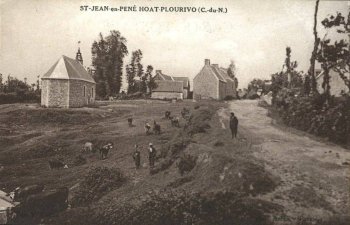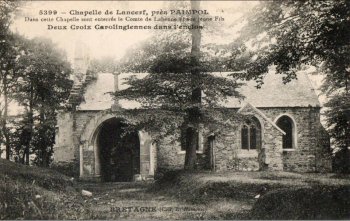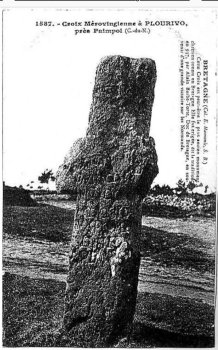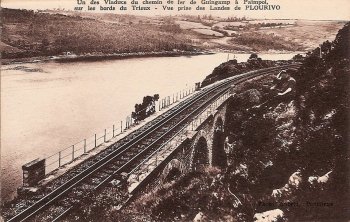Religious buildings
In Plourivo, you can see from far away the characteristic bell tower of the village church. The chapels were intended for important hamlets. Thus, in the town we could identify seven chapels. Only three of them remain today; they are the subject of entertainment and religious events.
Saint Peter’s Church
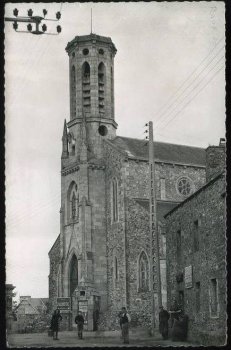
In the town, the parish church (1695) was a modest building covered with a thatched roof. In 1829, the city council considers that it is in bad condition and that it should be rebuilt. But it was not until 1862 that the decision was made
effectively.
The old church was razed December 6, 1863 and it is the young Louis Armez, engineer of Mines, who directs the construction of the building that one knows currently. It was completed in 1869 and cost taxpayers 89,340 francs.
Unlike neighboring churches built at the same time, the Plourivo Bell Tower is not covered. A spring just flowing to the site of the church would have banned the construction of a traditional steeple.
Inside, you can see the remains of the old church: two recumbent fifteenth century and a beautiful pulpit preaching, a lectern and baptismal funds onyx. A painting by Alphonse-François Le Hénaff representing the Virgin, Saint Dominic and Saint Catherine of Siena is on display.
St. Ambrose Chapel
Built in the hamlet of Kerleau, the Saint Ambroise Chapel dates from the end of the 19th century. It houses three ancient statues and a naive altarpiece. In the enclosure, the fountain was once famous for its fresh and clear water that healed eye disorders. The young women came to put their young child under the protection of the saint. A resident of the town recently created a statuette of Saint Ambrose, which was installed in the niche of the fountain.
The Chapel Saint John of Penhoat
The 16th century building was remodeled in the 20th century. It belonged to Roquel du Bourblanc who had bought the rights to Rohan-Guéméné. However, the armored stone reused in the bedside is in the groove of Rufflault and Plusquellec de Boisriou, lords of Kerhuel in the eighteenth century. A deed of sale dated from the year II reveals that the chapel was much larger than today. The cellar was left outside during its reconstruction.
The place has changed little since the beginning of the century.
The Chapel of Lancerf
This chapel dominates the valley of Trieux. The oldest building elements date from the 13th century. Widely remodeled over time, it has a steeple whose style recalls the steeples-walls Trégor.
It houses the tombs of the Count of Labenne (1845-1882), a natural son of Napoleon III, and his son Georges died in Paimpol in 1884. The wife of the count bought the chapel and had her husband buried with great pomp and his son; these grandiose funerals, baptized by the local press "back from the ashes", were celebrated in the presence of all that the region still counted nostalgic of the Empire.
Sold in 1958 as a ruin, it was stripped of the gate of the tomb of the Counts of Labenne, the stone overlooking the porch and a cross that is now at the cemetery of Loguivy de la Mer.
From 1959, the renovation is started by volunteers. In 1965, the chapel found its roof and its windows. The statue of Our Lady, after a stay at the parish church, returns to Lancerf. Today, the chapel is revived thanks to the Association of Friends of the Chapel, which organizes festivities for the renovation of this monument.
The medieval crosses
Plourivo is known for its medieval crosses (XI-XIII century?) Whose presence has fueled many legendary stories. None of these crosses is in its original location.
The epigraphy cross was near La Chapelle Neuve (now extinct); broken in 1909, she was transported near the Saint-Pierre church, against the wall of the cemetery. On May 6, 1911, it is classified as a historic monument under the title "movable object". In July 1981, the mayor Pierre Lhostis gets to have it installed in an enclosure on rue Alain Barbetorte.
The cross of Saint Ouarn, renamed abusively Croix d’Alain Barbetorte in 1906, in the enclosure of the street of the same name, was on the edge of a path nearby. It was registered in the supplementary inventory of Historic Monuments on February 5, 1927.
Two other crosses in the old Lancerf cemetery were moved: one to Ploubazlanec near Kertanouarn Manor, where it still stands; the other at Bréhat where she was brought back in 2002 to be relocated in front of the Lancerf Chapel, thanks to the action of the Friends of the Lancerf Chapel.
The windmills
In Plourivo, the climatic and topographical characteristics and the important hydrographic network naturally favored the establishment of mills. Despite its location, the town has not been equipped with a tide mill. On the other hand, 15 mills have been built but they have all but disappeared.
There were up to five windmills. There is almost no trace of it. They were regularly distributed since they were built in the following hamlets: Lancerf, Penhoat, Ruclé, Castel Auffret, well acquired. The 1831 cadastre reveals the location of the Lancerf mills, the Ruclé (in ruins since 1930 and disappeared to stone a road) and Bien Acquis, but no visible traces remain.
Nine water mills operated on the municipal territory. Those of Coat Frity and Traou Du were on the stream "Le Du". That of Traou Du had its water reservoir located more than 500 meters upstream. In the middle of the woods, stones reveal the presence of the Coat Frity mill. Its disemboweled dike is always visible further upstream.
The only mills that can still be seen today are the Guezennec mill and the Pontès mill. They are located on the Leff. After having resisted the upheavals of 1914, they worked for one until 1950, and the other until the 70s. They are now beautiful properties full of charm.
Railway
Formerly the town was crossed by a path connecting Paimpol to Pontrieux (extension of the Roman Way). At Frynaudour, to cross the Leff, the ferry was combined with a ford. Nationalized during the Revolution, he was put in adjucation. Threatened in 1840 by the project to build a bridge over the river, it disappeared gradually after the construction of the railway bridge in 1893.
Intended to stimulate economic activity, the Guingamp-Paimpol railroad was inaugurated on August 10, 1894. Two of its designers-developers are engineer Harel of Noah and Louis Armez. The bridge of Frynaudour would be partly composed of the stones of an old defensive castle on this point of the commune of Quemper-Guezennec between the two rivers. Frynaudour literally means "nose between two waters" because it is at the confluence of the Trieux and Leff.
The Guingamp-Paimpol railway line was renovated in 2017, and although for a moment the three stops at Plourivo’s request have been threatened, they have finally been preserved and are an asset for the mobility of the inhabitants.


